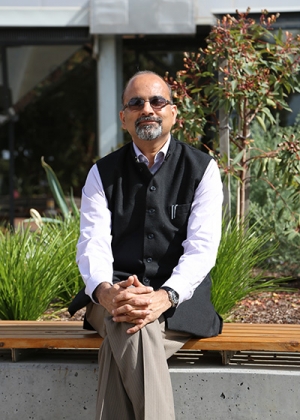Waste not, want not
Research news
Using fungi and plants to extract quality metals from contaminated waste might seem like something out of “Brave New World,” but this is the outcome expected from research being undertaken at the TERI-Deakin Nanobiotechnology Centre in India.
Trials are currently under way in India that use fungi to leach elements from soil and water. Unlike expensive and toxic chemical remediation, this biological option, known as “biomining,” is cheaper and “closes the circle,” recovering essential elements that can then be recycled back into the soil as fertiliser or used for other purposes.
During a recent visit to Deakin, the Director of the TERI-Deakin Nanobiotechnology Centre, Professor Alok Adholeya and several colleagues shared their research activities in “clean” nanoparticle synthesis, sustainable productivity, food security and bioremediation with Deakin researchers.
In relation to extracting metals from contaminated soils and other wastes, Professor Adholeya said that this research has enormous potential.
“In India, for instance, there is considerable cadmium and zinc contamination in areas around coal fired power stations. These metals could be extracted and turned into high quality metal salt or solution, for industrial use,” he explained.
Deakin’s Professor Leigh Ackland, from the School of Life and Environmental Sciences, who is undertaking related fungi research, said that she was “very impressed” with the activities at the TERI-Deakin centre.
“Apart from significant environmental benefits, biomining could contribute to major health improvements for people across the developing world,” Professor Ackland said.
“Intensive agriculture has led to soil depletion of nutrients, especially trace elements such as zinc. On a global scale, zinc deficiency, through malnutrition, is one of the major causes of mortality. Biomined zinc could be used to supply zinc fertiliser for crops.”
Biomining could be also be highly valuable in Australia, with researchers investigating extracting metals from solid, liquid and heavy metal waste. “In Australia there is a lot of solid waste from mining, especially zinc and iron,” Professor Adholeya added. “We are developing ways to collect these metals, convert them into nanoform, and then turn them into nutrients.”
The TERI-Deakin Nanobiotechnology Centre is set for a major boost, with a $10 million state-of-the-art facility to be constructed in Gual Pahari near New Delhi over the coming 12 months. This expansion will bring new labs and a large greenhouse to the centre, where research in transgenics and genetic modification will be included in the research mix.
Professor Adholeya said that this development will create further opportunities for industries to use the Centre as a bio-incubation facility, where they can jointly develop intellectual property with the Centre.
“We are creating a future skilled workforce in nanobiotechnology,” he said. “It is a very new discipline that is taking shape. We have very good facilities to carry out ‘next generation’ research.”
“The interaction between Deakin and TERI allows the centre to take advantage of the experience of both, to bring value to society. We are also looking forward to working with Deakin’s new Centre for Regional and Rural Futures (CeRRF), where a focus on engaging with policy and industry will be an excellent complement to our activities.”
Share this story
 Professor Alok Adholeya
Professor Alok Adholeya
